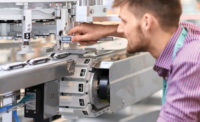PACK EXPO Connects: Columns
Hemp Packaging for Cannabis — and Beyond

Packaging is a primary focus for the growing cannabis-infused food and beverage industry, including products infused with health-focused non-psychoactive cannabidiol (CBD)—which have global appeal—and those infused with tetrahydrocannabinol (THC), which compete with beer, wine, and spirits in the 11 U.S. states plus the District of Columbia, which have all rescinded cannabis prohibition for adults.
While FDA is still assessing the safety of CBD in foods and beverages, cannabis-infused products are widely available on the market — particularly in states that have fully legalized cannabis products. This has left regulatory oversight to the individual states. THC-infused foods and beverages have strict labeling protocols, and require child-resistant packaging. The burgeoning cannabis food and beverage market is also highly brand-focused, with emerging demographics gaining new levels of exposure to the products. All of these factors often lead to products that have diverse packaging needs — often too much packaging, with redundancies and concerns about waste and sustainability. These diverse needs have also created a strong climate for innovation.
One packaging solution comes from the cannabis plant itself. “Sustainable packagers with a cannabis focus are now popping up,” said Sean M. Riley, senior director, media and industry communications, PMMI, in a recent article for Cannabis Products magazine (“Streamlining cannabis food and beverage packaging”), a new BNP Media publication focused on the development and production of cannabis-infused foods and beverages.
“Sana Packaging in Denver, for example, only creates packages made from 100% hemp plastic and 100% reclaimed ocean plastic,” said Riley. The company focuses on the cannabis industry, designing and developing differentiated, sustainable, and regulatory-compliant packaging solutions using 100 percent plant-based hemp plastic, 100% reclaimed ocean plastic, and other sustainable materials.
Hemp will likely make a major impact on packaging sustainability over the next few years, said Tom Newmaster, Tom Newmaster, partner, FORCEpkg, Lancaster, Pennyslvania, in the article — and not just as a bioplastic. “It’s widely considered more renewable, and many believe it makes a better and even stronger paper substrate. Now that we can once again use hemp vs. wood pulp to make packaging materials, look for advances, combinations, and new materials based on this old/new component. It will be interesting to see if cannabis learns more from traditional consumer products, or if cannabis will lead traditional products to a more-sustainable path.”
Packaging made from hemp can often work in the same equipment used to manufacture petroleum-based packaging for foods and beverages. Likewise, paper packaging equipment companies have developed sustainable paper packaging solutions that work on existing equipment.
A key benefit of bioplastics is their highly biodegradable nature. Hemp bioplastics often decompose within six months, and sometimes as soon as three months.
The Global Industrial Hemp Market was valued at $3.4 billion in 2018 and is expected to reach $41.8 billion by 2027 with a CAGR of 32.0%, according to “Industrial Hemp — Global Market Outlook (2018-2027).”
In the wake of the 2018 Farm Bill, which legalized hemp cultivation nationwide, an increasing number of farmers have converted acreage to the crop. Hemp (Cannabis sativa) is a highly efficient crop in terms of water and nutrient needs, making it an attractive option. Also, it sequesters carbon dioxide from the atmosphere, helping mitigate global warming. Nearly every part of the hemp plant can enjoy commercial viability — including the health-focused cannabidiol (CBD) extracted from its flowers used in a growing range of foods and beverages, and the cellulose for packaging.
View all PACK EXPO Preview Articles
Looking for a reprint of this article?
From high-res PDFs to custom plaques, order your copy today!






